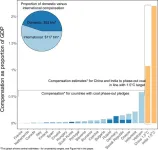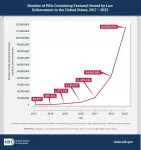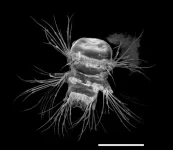(Press-News.org) Coal phase-out is necessary to solve climate change, but can have negative impacts on workers and local communities dependent on coal for their livelihoods. Researchers at Chalmers University of Technology in Sweden and Central European University in Austria have studied government plans for coal phase-out around the world and discovered that more than half of such plans include monetary compensation to affected parties. This planned compensation globally amounts to USD 200 billion, but it excludes China and India, the two largest users of coal that currently do not have phase-out plans. The study shows that if China and India decide to phase out coal as fast as needed to reach the Paris climate targets and pay similar compensation, it would cost upwards of USD 2 trillion.
To slow global warming, coal use needs to end. Many governments, mostly in Europe, have begun to phase-out coal, but these policies can harm companies, risk unemployment, and lead to economic hardship for coal-dependent regions. In response, some countries have adopted what are known as ‘just transition’ strategies, where governments support negatively impacted companies, workers, and regions. Germany for example, has pledged over EUR 40 billion to support those affected by coal phase-out.
“Previously, coal phase out has often been blocked by the interests opposing it. Many countries have put money on the table through ‘just transition’ strategies which has made coal phase-out politically feasible,” says Jessica Jewell, Associate Professor at Chalmers University of Technology, and one of the authors of the study.
The researchers have studied all countries with coal phase-out plans around the world and found that those with the most coal power production and with plans for rapid phase-out, have compensation policies in place.
In total, these 23 countries with 16 percent of the world’s coal power plants have pledged about USD 209 billion in compensation. This may sound like a lot of money, but the researchers point out that it equates to roughly 6 gigatons of avoided CO2 emissions and the cost of compensation for coal phase-out per tonne of avoided CO2 emissions (USD 29-46 per tonne) is actually well below recent carbon prices in Europe (~USD 64-80 per tonne).
“So far these ‘just transition’ policies are consistent with, or lower than, the carbon prices within the EU, which means they make sense in terms of climate change. But more funding is likely needed if we want to reach the Paris climate target,” says Jewell.
This is because achieving the goals of the Paris climate agreement will not be possible without participation of the world’s major coal consumers, China and India, which have more than half of the world’s coal plants, but no phase-out plans currently in place. The study finds that, for China and India to adopt compensation policies similar to those already in place, the estimated compensation amount for both countries would be USD 2.4 trillion for the 2°C target and USD 3.2 trillion for the 1.5°C target.
“The estimated compensation for China and India is not only larger in absolute terms, but would also be more expensive compared to their economic capacities”, says Lola Nacke, a doctoral student at Chalmers University of Technology, and one of the authors of the study.
A big question thus is where such large sums of money would come from. Today about half of all compensation is funded from international sources such as Just Energy Transition Partnerships* supporting coal phase-out in Vietnam, Indonesia and South Africa. International finance might also be needed to support future coal phase-out compensation in major coal consuming countries. However, the researchers point out that the estimated amounts of compensation for China and India alone are comparable to the entire international climate finance pledged in Paris, and larger than current international development aid to these countries.
“Discussions about the cost of climate change mitigation often focus on investments in renewable energy technologies – but we also see it’s essential to address social implications of fossil fuel decline to enable rapid transitions”, says Lola Nacke.
Fact Box:
*Just Energy Transition Partnerships – Just Energy Transition Partnerships (JETPs) are new multi-lateral structures for accelerating the phase-out of fossil fuels. These intergovernmental partnerships coordinate financial resources and technical assistance from countries in the Global North to a recipient country to help it in this regard. JETPs related to coal phase-out are currently in place for Vietnam, Indonesia and South Africa.
EU Just Transition Fund – The fund is the first pillar of the Just Transition Mechanism. The Commission provides support to Member States having identified the territories expected to be the most negatively impacted by the transition towards climate-neutrality. The Just Transition Fund supports the economic diversification and reconversion of the territories concerned.
Paris Climate Agreement – To tackle climate change and its negative impacts, world leaders at the UN Climate Change Conference (COP21) in Paris reached a breakthrough on 12 December 2015: the Paris Agreement. The Agreement sets long-term goals to guide all nations to:
substantially reduce global greenhouse gas emissions to hold global temperature increase to well below 2°C above pre-industrial levels and pursue efforts to limit it to 1.5°C above pre-industrial levels, recognising that this would significantly reduce the risks and impacts of climate change.
provide financing to developing countries to mitigate climate change, strengthen resilience and enhance abilities to adapt to climate impacts.
More about the research:
The research is presented in the paper: " Compensating affected parties necessary for rapid coal phase-out but expensive if extended to major emitters", published in the journal Nature Communications.
The researchers involved in the study are Lola Nacke, Vadim Vinichenko, Aleh Cherp, Avi Jakhmola and Jessica Jewell, and they are active at Chalmers University of Technology, Sweden; Central European University, Austria; Lund University, Sweden; University of Bergen, Norway and International Institute for Applied Systems Analysis, Austria.
For more information, please contact:
Lola Nacke, Doctoral Student, Division of Physical Resource Theory, Department of Space, Earth and Environment, Chalmers University of Technology, Sweden, lolan@chalmers.se
Jessica Jewell, Associate Professor, Division of Physical Resource Theory, Department of Space, Earth and Environment, Chalmers University of Technology, Sweden, jewell@chalmers.se, +46 31 772 61 06
The contact persons speak English and are available for live and pre-recorded interviews. At Chalmers, we have podcast studios and broadcast filming equipment on site and would be able to assist a request for a television, radio or podcast interview.
Caption for figure: Estimated compensation for China and India to meet 1.5°C (orange) is not only larger in absolute terms but also would require a larger share of their GDPs.
NOTE TO THE EDITOR - IMAGES:
The Chalmers Press portal can be accessed here and you can search for any images or videos.
We kindly request credit to be given in the following format where possible:
Image/Graphic/Illustration: Chalmers University of Technology | Name Surname
Images provided in Chalmers University of Technology press releases are, unless specified otherwise, free for download and publication as long as credit is given to the University and the individual creator. Cropping and rescaling of the images is permitted when required for adaptation to the publication’s format, but modifications that would influence the message and content of the original are not. The material is primarily intended for journalistic and informative use, to assist in communication and coverage of Chalmers’ research and education. Commercial usage, for example the marketing of goods and services, is not permitted.
END
New Study: The price tag of phasing-out coal
2024-05-13
ELSE PRESS RELEASES FROM THIS DATE:
Dramatic increase in fentanyl seized by authorities in last six years
2024-05-13
The number of illicit fentanyl seizures by law enforcement in the United States grew by more than 1,700 percent between 2017 and 2023, according to a new analysis. Further, the share of total fentanyl seizures that involved pills quadrupled over the same period–with the 115.6 million pills seized in 2023 representing 49 percent of total seizures.
This is the first time that such up-to-date seizure data has been published differentiating between fentanyl powder and pills, says the research team led by experts at NYU Grossman School of Medicine and the University of Florida.
Law enforcement drug seizures are used as a proxy for drug availability ...
What makes a memory? It may be related to how hard your brain had to work
2024-05-13
New Haven, Conn. — The human brain filters through a flood of experiences to create specific memories. Why do some of the experiences in this deluge of sensory information become “memorable,” while most are discarded by the brain?
A computational model and behavioral study developed by Yale scientists suggests a new clue to this age-old question, they report in the journal Nature Human Behavior.
“The mind prioritizes remembering things that it is not able to explain very well,” said Ilker Yildirim, an ...
Over 115 million pills containing illicit fentanyl seized by law enforcement in 2023
2024-05-13
Law enforcement seizures of illicit fentanyl increased dramatically in number and size between 2017 to 2023 in the U.S., especially in pill form, according to a new study funded by the National Institutes of Health’s (NIH) National Institute on Drug Abuse (NIDA). The number of individual pills containing fentanyl seized by law enforcement was 2,300 times greater in 2023 compared to 2017, with 115,562,603 pills seized in 2023 vs. 49,657 in 2017. The proportion of fentanyl pill seizures to the total number of fentanyl seizures more than quadrupled, ...
Nature's 3D printer: bristle worms form bristles piece by piece
2024-05-13
A new interdisciplinary study led by molecular biologist Florian Raible from the Max Perutz Labs at the University of Vienna provides exciting insights into the bristles of the marine annelid worm Platynereis dumerilii. Specialized cells, so-called chaetoblasts, control the formation of the bristles. Their mode of operation is astonishingly similar to that of a technical 3D printer. The project is a collaboration with researchers from the University of Helsinki, Vienna University of Technology and Masaryk University in Brno. The study was recently published in the renowned journal Nature Communications.
Chitin is ...
Research shows that ‘softer’ proteins can cross into the nucleus quicker
2024-05-13
Researchers at the Francis Crick Institute and King’s College London have discovered that how soft or rigid proteins are in certain regions can dictate how fast or slow they enter the nucleus.
Proteins need to come in and out of the nucleus, the control centre of the cell, to give different functions, such as telling the nucleus to switch on or off certain genes. These proteins cross using a channel on the edge of the nucleus called the ‘nuclear pore complex’.
Previous research has shown that the size and composition of these proteins change how easily they can cross, but now this research, published today in Nature Physics, has shown that mechanical properties can also ...
Birth by C-section more than doubles odds of measles vaccine failure
2024-05-13
PRESS RELEASE FROM THE UNIVERSITY OF CAMBRIDGE
EMBARGOED UNTIL 10:00 LONDON TIME (BST)/ 05:00 US ET ON MONDAY 13 MAY 2024
A copy of the paper and photographs are available at:
https://drive.google.com/drive/folders/1Rfv2ywq7jhHLPuhKZ_ihs6TinuLHCJmU?usp=sharing
Peer-reviewed / Meta-analysis / People
A study by the University of Cambridge, UK, and Fudan University, China, has found that a single dose of the measles jab is up to 2.6 times more likely to be completely ineffective in children born by C-section, compared to those born naturally.
Failure of the vaccine means that the child’s immune system does not produce antibodies to fight ...
How do obesity and metabolic syndrome affect women’s risks of breast cancer and cancer-related death?
2024-05-13
In the Women’s Health Initiative (WHI) randomized trial, a low-fat diet reduced breast cancer mortality, especially in women with more metabolic syndrome (MetS) components (obesity, high blood pressure, elevated blood sugar, and abnormal cholesterol). A recent analysis of WHI findings indicates that MetS and obesity each have different associations with breast cancer subtypes and mortality risk. The findings are published by Wiley online in CANCER, a peer-reviewed journal of the American Cancer Society.
The analysis ...
KITECH develops deformable energy storage device via laser technology
2024-05-13
The joint research team, led by Dr. Chanwoo Yang and Researcher Seong Ju Park from Korea Institute of Industrial Technology(KITECH), along with Prof. Jin Kon Kim and Dr. Keon-Woo Kim from POSTECH, has successfully developed a compact energy storage device with excellent elasticity. This research was published in the world-renowned journal in the field of electronic engineering, 'npj Flexible Electronics'.
Beyond foldable and rollable devices, the era of stretchable IT devices is arriving. For these devices, the development of small, elastic energy storage devices is essential. In this respect, micro supercapacitors ...
Deeply entrenched school psychology practices can be ‘harmful to children’
2024-05-13
Many programs ‘deeply entrenched in school culture’ are harmful to children and can cause potentially lasting damage, psychologists have warned.
They say these practices, from abstinence-only sex education to zero tolerance policies, can direct considerable funds away from evidence-based strategies, as well as giving pupils misleading information.
In new book Investigating School Psychology, researchers have carried out an exhaustive review of current literature to look at practices that continue to exist with little to no scientific ...
Projected estimates of cancer in Canada in 2024
2024-05-13
The number of cancer cases and deaths in Canada is expected to increase because of a growing and aging population, but the overall rates of people being diagnosed with and dying from cancer will continue to decline, according to the latest cancer trends research in CMAJ (Canadian Medical Association Journal) https://www.cmaj.ca/lookup/doi/10.1503/cmaj.240095.
The study is the result of a collaboration between the Canadian Cancer Society, Statistics Canada, and the Public Health Agency of Canada. It provides estimates of the number ...





